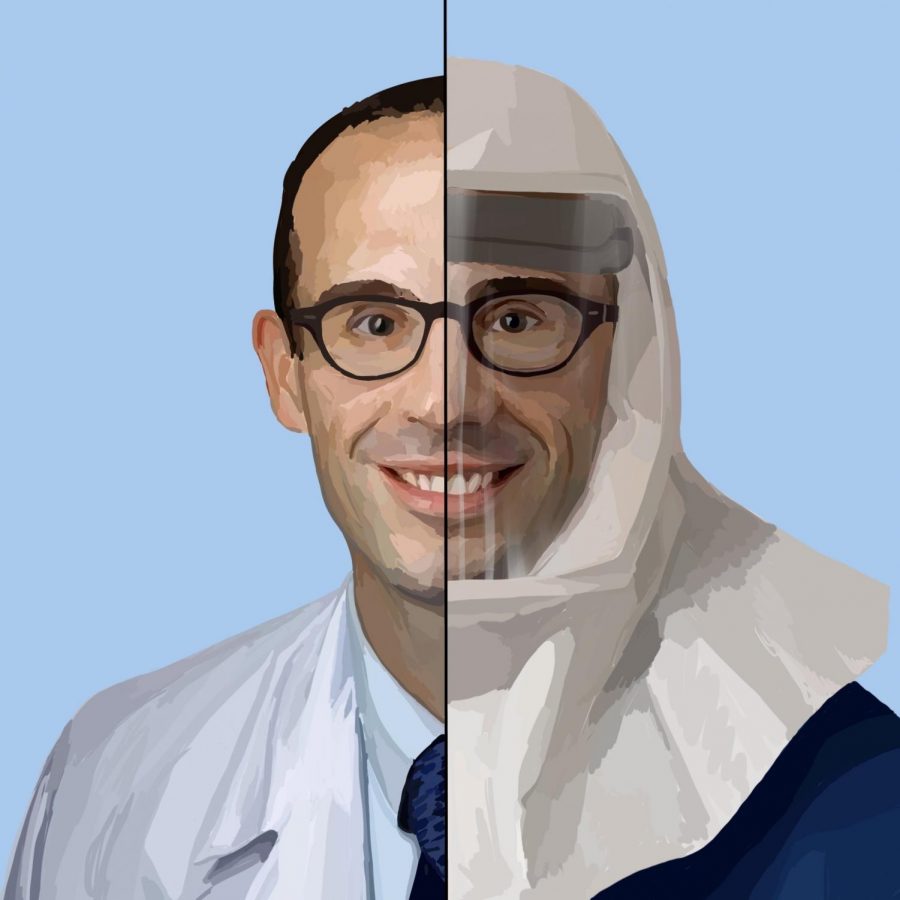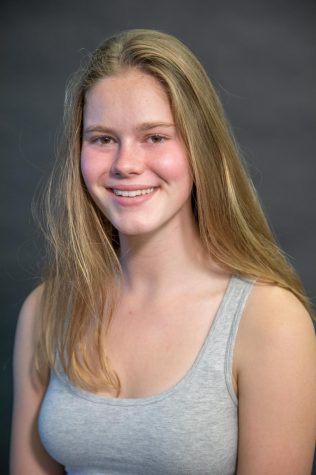Behind the Mask: Dr. Brian Thomas Garibaldi
A portrait of Dr. Brian Thomas Garibaldi. Though Johns Hopkins has limited the number of people who go into patient rooms and doctors must wear heavy PPE, patients get to schedule Zoom calls with their families on tablets. Staff illustration: Grace Tang.
May 31, 2020
Staff Illustration by Grace Tang.
Behind the Mask is a series exploring the lives of five medical professionals and how their lives have changed because of coronavirus. This is part two of five, a profile on Dr. Brian Thomas Garibaldi, the director of the Johns Hopkins Biocontainment Unit.
———
The Johns Hopkins Biocontainment Unit (BCU) opened for its first person under investigation (PUI) for coronavirus on Feb. 29. From that day to March 20, Medical Director of the Johns Hopkins BCU Dr. Brian Thomas Garibaldi and his team were in charge of caring for coronavirus patients, specifically the first 11. As of May 12, all 24 beds in the Intensive Care Unit (ICU) are occupied by patients on the breathing machine with Acute Respiratory Distress Syndrome (ARDS), which is widespread inflammation of the lungs, whereas before the pandemic there were only three or four at a time. The BCU is closed now and members of Garibaldi’s team are taking care of coronavirus patients across several ICUs that are equipped to hold more people.
Garibaldi told The Coat of Arms that he and his team had not activated the BCU since September of 2015. “We had been training for a number of years and work well together, but that [March] was really hard. There was a lot of uncertainty about what we were doing, if we were doing the right things and if we were being safe,” he said.
Many people on his team did not go home for weeks and stayed at the hospital. Garibaldi stayed at a hotel across the street after a particularly long night shift. “[I wanted] to stay close to the hospital, but I also didn’t want to have to worry about coming home and [putting my family] at risk until we had a better sense of the dynamics of the virus,” he said.
Despite the risks of contracting the virus, Garibaldi said there is also excitement about new therapies and trials. “My generation of physicians just missed the height of the HIV epidemic. When I was an intern, most of our ICU patients had end-stage AIDS, but over a very short period of time we had effective treatments and HIV became more of a chronic condition than a fatal disease,” Garibaldi said. “For most of us, this may be the only time in our careers that we get to see a completely new disease. It comes with a lot of pressure and responsibility.”
A big part of Garibaldi’s life that the pandemic changed was teaching. Before the pandemic, he taught bedside manner to medical students, but that program has been shut down in the effort to minimize the number of people who go into patient rooms. “It’s been hard for those of us who care deeply about making sure that we’re passing on the skills that were passed on to us to the next generation,” he said.
According to Garibaldi, most hospitals are not allowing visitors unless the patient has a disability or is at the end of their life. “[In that case,] we rely on the family to tell us who the person is and what’s important to them, so we’ve lost a little bit of that connection to our patients,” he said. He said it’s also very hard on the patients because often they don’t see anyone other than their nurse a couple times a day. However, all of the rooms in the BCU have tablets where families can schedule Zoom calls through the nursing staff, and some of the ICU staff have started doing video interviews with families and friends to show to patients.
The coronavirus is a strain on health care providers. “I literally went a month without touching another person without wearing two sets of gloves,” Garibaldi said. “I think that the value of human touch is hard to quantify, but it’s important to [both] patients and providers.”
When the outbreak of coronavirus first started, Garibaldi’s wife, son and daughter went to shelter-in-place with family in Pittsburgh, but even when they came home he self-isolated himself from them. However, they are all home now. “It became clear that this is not going away anytime soon, and staying away from them for a year is not an option,” he said.
Garibaldi began his career doing research and working in the ICU but then temporarily moved to Kuala Lumpur, Malaysia, where Johns Hopkins, his current workplace in Baltimore, MD, has a medical school. His time in Kuala Lumpur ended abruptly, and he went back to Baltimore in 2014, a year earlier than he expected, which was right around the time Ebola was identified in the U.S.
After he suggested that all Johns Hopkins doctors should learn to care for Ebola patients, Garibaldi, the hospital architect, the lead clinical engineer and other members of the staff teamed up to build the BCU. “I’m really proud of all the work we’ve done over the last five years because our team, by being ready and handling the first three weeks of the response, gave the rest of the hospital time to gear up,” Garibaldi said. He said he expects that his team will take care of the final coronavirus patients as well.






Lasloudjikamel • Oct 5, 2020 at 2:30 am
I often visit doctor as cardiologist and I’ll want got advices from American doctors I be glad to read your medical article with Sophia Artandi news
I find it very exciting